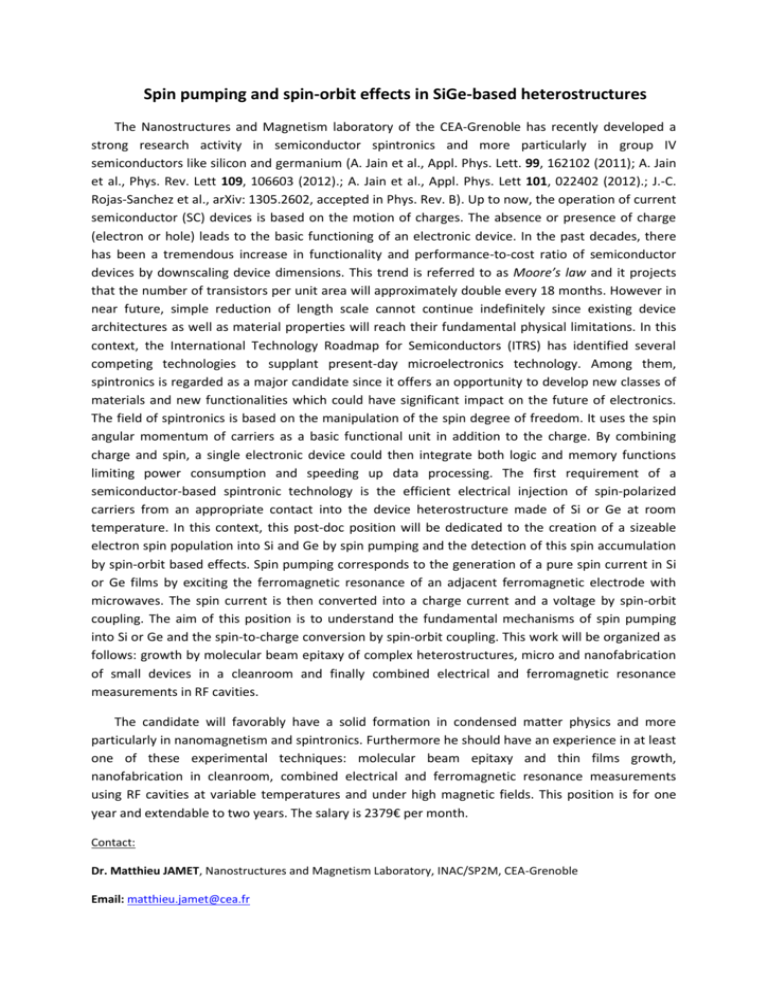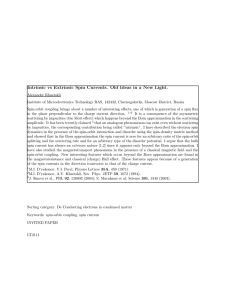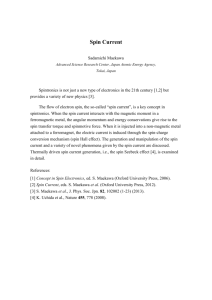MOOREA_proposal (18 Ko)
advertisement

Spin pumping and spin-orbit effects in SiGe-based heterostructures The Nanostructures and Magnetism laboratory of the CEA-Grenoble has recently developed a strong research activity in semiconductor spintronics and more particularly in group IV semiconductors like silicon and germanium (A. Jain et al., Appl. Phys. Lett. 99, 162102 (2011); A. Jain et al., Phys. Rev. Lett 109, 106603 (2012).; A. Jain et al., Appl. Phys. Lett 101, 022402 (2012).; J.-C. Rojas-Sanchez et al., arXiv: 1305.2602, accepted in Phys. Rev. B). Up to now, the operation of current semiconductor (SC) devices is based on the motion of charges. The absence or presence of charge (electron or hole) leads to the basic functioning of an electronic device. In the past decades, there has been a tremendous increase in functionality and performance-to-cost ratio of semiconductor devices by downscaling device dimensions. This trend is referred to as Moore’s law and it projects that the number of transistors per unit area will approximately double every 18 months. However in near future, simple reduction of length scale cannot continue indefinitely since existing device architectures as well as material properties will reach their fundamental physical limitations. In this context, the International Technology Roadmap for Semiconductors (ITRS) has identified several competing technologies to supplant present-day microelectronics technology. Among them, spintronics is regarded as a major candidate since it offers an opportunity to develop new classes of materials and new functionalities which could have significant impact on the future of electronics. The field of spintronics is based on the manipulation of the spin degree of freedom. It uses the spin angular momentum of carriers as a basic functional unit in addition to the charge. By combining charge and spin, a single electronic device could then integrate both logic and memory functions limiting power consumption and speeding up data processing. The first requirement of a semiconductor-based spintronic technology is the efficient electrical injection of spin-polarized carriers from an appropriate contact into the device heterostructure made of Si or Ge at room temperature. In this context, this post-doc position will be dedicated to the creation of a sizeable electron spin population into Si and Ge by spin pumping and the detection of this spin accumulation by spin-orbit based effects. Spin pumping corresponds to the generation of a pure spin current in Si or Ge films by exciting the ferromagnetic resonance of an adjacent ferromagnetic electrode with microwaves. The spin current is then converted into a charge current and a voltage by spin-orbit coupling. The aim of this position is to understand the fundamental mechanisms of spin pumping into Si or Ge and the spin-to-charge conversion by spin-orbit coupling. This work will be organized as follows: growth by molecular beam epitaxy of complex heterostructures, micro and nanofabrication of small devices in a cleanroom and finally combined electrical and ferromagnetic resonance measurements in RF cavities. The candidate will favorably have a solid formation in condensed matter physics and more particularly in nanomagnetism and spintronics. Furthermore he should have an experience in at least one of these experimental techniques: molecular beam epitaxy and thin films growth, nanofabrication in cleanroom, combined electrical and ferromagnetic resonance measurements using RF cavities at variable temperatures and under high magnetic fields. This position is for one year and extendable to two years. The salary is 2379€ per month. Contact: Dr. Matthieu JAMET, Nanostructures and Magnetism Laboratory, INAC/SP2M, CEA-Grenoble Email: matthieu.jamet@cea.fr

![HJi exp [(xb + xa) cos(wot) — 2xbx.])](http://s2.studylib.net/store/data/010971245_1-ca5a45e9550482d4b1daaee0746eb6fa-300x300.png)









